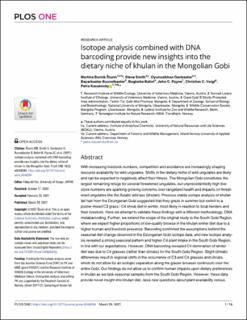| dc.contributor.author | Šturm, Martina Burnik | |
| dc.contributor.author | Smith, Steve | |
| dc.contributor.author | Ganbaatar, Oyunsaikhan | |
| dc.contributor.author | Buuveibaatar, Bayarbaatar | |
| dc.contributor.author | Balint, Boglarka | |
| dc.contributor.author | Payne, John C. | |
| dc.contributor.author | Voigt, Christian C. | |
| dc.contributor.author | Kaczensky, Petra | |
| dc.date.accessioned | 2023-02-28T14:23:24Z | |
| dc.date.available | 2023-02-28T14:23:24Z | |
| dc.date.created | 2021-06-02T08:54:13Z | |
| dc.date.issued | 2021 | |
| dc.identifier.issn | 1932-6203 | |
| dc.identifier.uri | https://hdl.handle.net/11250/3054745 | |
| dc.description.abstract | With increasing livestock numbers, competition and avoidance are increasingly shaping resource availability for wild ungulates. Shifts in the dietary niche of wild ungulates are likely and can be expected to negatively affect their fitness. The Mongolian Gobi constitutes the largest remaining refuge for several threatened ungulates, but unprecedentedly high livestock numbers are sparking growing concerns over rangeland health and impacts on threatened ungulates like the Asiatic wild ass (khulan). Previous stable isotope analysis of khulan tail hair from the Dzungarian Gobi suggested that they graze in summer but switch to a poorer mixed C3 grass / C4 shrub diet in winter, most likely in reaction to local herders and their livestock. Here we attempt to validate these findings with a different methodology, DNA metabarcoding. Further, we extend the scope of the original study to the South Gobi Region, where we expect higher proportions of low-quality browse in the khulan winter diet due to a higher human and livestock presence. Barcoding confirmed the assumptions behind the seasonal diet change observed in the Dzungarian Gobi isotope data, and new isotope analysis revealed a strong seasonal pattern and higher C4 plant intake in the South Gobi Region, in line with our expectations. However, DNA barcoding revealed C4 domination of winter diet was due to C4 grasses (rather than shrubs) for the South Gobi Region. Slight climatic differences result in regional shifts in the occurrence of C3 and C4 grasses and shrubs, which do not allow for an isotopic separation along the grazer-browser continuum over the entire Gobi. Our findings do not allow us to confirm human impacts upon dietary preferences in khulan as we lack seasonal samples from the South Gobi Region. However, these data provide novel insight into khulan diet, raise new questions about plant availability versuspreference, and provide a cautionary tale about indirect analysis methods if used in isolation or extrapolated to the landscape level. Good concordance between relative read abundance of C4 genera from barcoding and proportion of C4 plants from isotope analysis adds to a growing body of evidence that barcoding is a promising quantitative tool to understand resource partitioning in ungulates. | en_US |
| dc.language.iso | eng | en_US |
| dc.rights | Navngivelse 4.0 Internasjonal | * |
| dc.rights.uri | http://creativecommons.org/licenses/by/4.0/deed.no | * |
| dc.title | Isotope analysis combined with DNA barcoding provide new insights into the dietary niche of khulan in the Mongolian Gobi | en_US |
| dc.type | Peer reviewed | en_US |
| dc.type | Journal article | en_US |
| dc.description.version | publishedVersion | en_US |
| dc.rights.holder | © 2021 The Authors | en_US |
| dc.subject.nsi | VDP::Zoologiske og botaniske fag: 480 | en_US |
| dc.subject.nsi | VDP::Zoology and botany: 480 | en_US |
| dc.source.volume | 16 | en_US |
| dc.source.journal | PLOS ONE | en_US |
| dc.source.issue | 3 | en_US |
| dc.identifier.doi | 10.1371/journal.pone.0248294 | |
| dc.identifier.cristin | 1913173 | |
| dc.relation.project | Andre: Austrian Science Fund (FWF) | en_US |
| dc.relation.project | Andre: Research Inst of Wildl Ecol, Univ Vet Med of Vienna | en_US |
| dc.relation.project | Norges forskningsråd: 251112 | en_US |
| cristin.ispublished | true | |
| cristin.fulltext | original | |
| cristin.qualitycode | 1 | |

